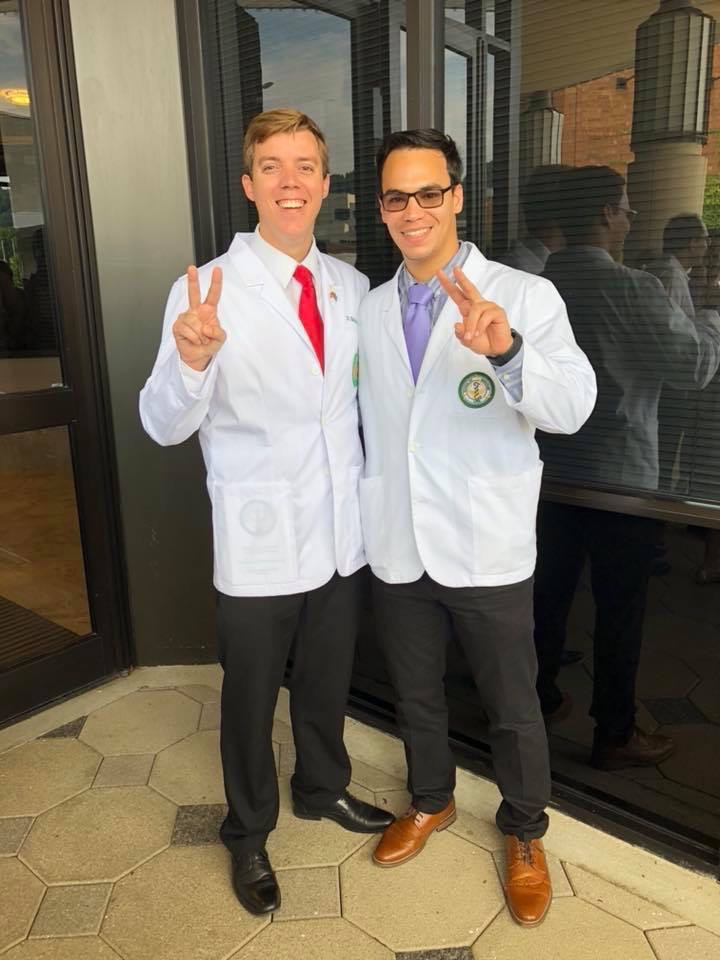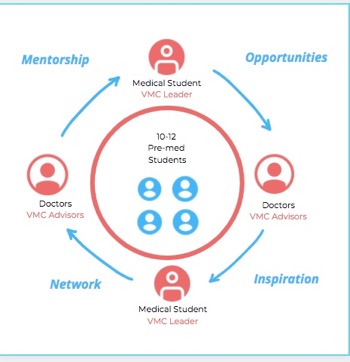 For many aspiring medical students, the steps required to become a doctor may not be obvious. Things such as taking appropriate undergraduate courses, entry exams, internship programs, and residency are just a few things for which applicants have to be prepared. Thankfully, those with a family friend who is a physician or who make regular trips to the doctor, get exposure to medical professionals at an early age— which is critical in the development of one’s career.
For many aspiring medical students, the steps required to become a doctor may not be obvious. Things such as taking appropriate undergraduate courses, entry exams, internship programs, and residency are just a few things for which applicants have to be prepared. Thankfully, those with a family friend who is a physician or who make regular trips to the doctor, get exposure to medical professionals at an early age— which is critical in the development of one’s career.
Now, take a moment to imagine navigating the medical education system in a foreign country, whose primary language isn’t your own. With a career choice such as medicine, this dream could be a seemingly daunting mission.
Thankfully, the passion that fueled Julio Cesar and Dasiel Bellido De Luna, who are currently MS4 and MS3 respectively at UAB School to Medicine, to pursue their medical degree outweighed the fears and uncertainty that inevitably raced through their minds.
Born and raised in Cuba, Julio and Dasiel had been friends since high school. Unlike the U.S., medical school in Cuba begins after high school. So, after graduation in 2008, they started their journey to become physicians.
Julio Cesar
At the end of their second year in Cuban medical school, Julio’s father—who had already received his U.S. Citizenship—petitioned to have Julio join him in the United States. However, with his mother also out of the country, as part of the Cuban-American Parole Program, this put Julio in a complicated situation. In Cuba, persons deemed “essential” were not allowed to bring their children out of the country. To do so could be considered treason.
By law, children such as Julio were at the discretion of the government before joining their family abroad. Unable to continue pursuing his medical degree in Cuba, but not yet approved to travel to the U.S., it was unbeknownst to him if it would be two, three, five, or more years before he was reunited with his father. To help facilitate the process, Julio’s grandmother helped him plead his case to the Cuban government
Dasiel Bellido De Luna
A few months after Julio’s father filed his paperwork, Dasiel’s aunt reached out to his mother about applying for the Cuban Family Reunification Parole Program. If accepted into this program, Dasiel would be allowed to join his family in the U.S. and attend medical school.
However, since Dasiel’s education in Cuba was free, there was concern that the government would declare him too far along in his medical training to leave. Or, if Dasiel was allowed to leave, there was the fear and doubt that years of hearing misconceptions about the U.S. medical education system had instilled in him. Things such as, “it’s only for the elite,” “medicine is impossible to do,” or “you have to be rich.”
To get some guidance, Dasiel reached out to his cousin, who had become a pharmacist in the United States. This advice gave Dasiel and Julio their first look at the journey that awaited them.
Journey to Medical School
Julio and Dasiel, each on their journey to America, were approved about two years after filing—November 2012 and March 2013, respectively. Being the first to arrive, Julio immediately began hitting the ground

running. Living close to Florida International University (FIU), Julio smiled as he reflected on the process and said, “I brought my medical school transcript to FIU and said, ’I want to go to medical school,’ but they told me, ‘this isn’t the way it works—there is a tiered step process.’”
Disappointed by the news, Julio was encouraged and advised by his father to make the first step, taking the TOEFL. After completing this first obstacle, Julio was able to enroll in undergraduate studies at FIU. After learning what he needed to do, he would share the information with Dasiel back in Cuba. Then, four short months after Julio arrived in the U.S., Dasiel was granted admittance into the Reunification Program and traveled to the states.
Once in the U.S., Dasiel learned from Julio and started the necessary steps toward medical school. Along the way, the guys had to actively seek out the resources and mentors needed to succeed. Things such as tips for having a competitive application to writing a personal statement weren’t always evident.
Upon learning about UAB, Julio was impressed by the welcoming nature of the faculty and staff and saw the impact he could make by studying at an institution like UAB. After speaking with the SOM Office for Diversity and Inclusion team, Julio committed to making UAB his new home.
Then, when it was time for Dasiel to choose a medical school, he was already familiar with UAB since Julio was accepted a year prior. However, to get his own perspective, Dasiel talked with Dr. Carlton Young, Assistant Dean for Medical Student Diversity and Inclusion and Surgeon (Dasiel’s area of interest). After meeting with Dr. Young and the ODI team, Dasiel knew UAB was the right place for him to pursue a medical degree.
Dasiel explains, “It’s quite complicated to get your papers in order to even apply [for medical school]. Then, for us, we were coming from another country with a different language. In a short period of time, we had to digest all the information and determine the best way to apply as a successful candidate. It’s not just about having the qualifications, but also being competitive with people who are just as smart and perhaps better connected.”
Creating a Passion for Medicine
Through Julio’s father, Julio and Dasiel were connected with Dr. Heval Kelli, creator of the Young Physician’s Initiative. Hearing Dr. Kelli’s story, along with their own shared experiences, caused Julio and Dasiel to resonate with the mission of YPI.
As a Syrian-Kurdish Refugee, Kelli started out washing dishes at a restaurant in front of Emory. It was here that he met a heart surgeon, Dr. Lattouf, who would serve as his mentor. Years later, while completing his fellowship at Emory, he decided to create an organization that would, as their story explains, “make medical mentorship and networking an opportunity for all, not just a matter of luck.”
Often in underserved communities, families don’t know anyone who has gone through the process of becoming a medical professional. In some circumstances, many vulnerable populations may not even have access to regular trips to the doctor. So how do kids and teens in these demographics have dreams and set goals to become doctors?
Julio explains, “We did everything we did when we came to this country, despite the obstacles, to pursue medical degrees because we already knew what medicine was. We already had that passion and drive inside us from our past experiences. But one of the ways you create that for people who don’t know is by being in contact with physicians or medical students—learning what medicine is.” Dasiel adds, “you have to have exposure.”
For Dasiel, this exposure comes through first-hand experiences. When he was five years old, he had to go through surgery. It was his experience with a pediatric surgeon that gave him the idea to become a doctor. When he reached his junior year of high school, he knew it was time to commit to that decision. To get a better sense of if it was right for him, he shadowed one of his father’s friends, a cardiologist. It was here that Dasiel confirmed his dreams of becoming a physician, and a passion for medicine took hold.
Julio’s inspiration to study medicine came through a bond with his grandfather, a dentist. When Julio was about 15, his grandpa gave him a large book on pathology. Confused, but up for the challenge, Julio read through it and one day at dinner began discussing Cancer. This conversation led to others and then, an invitation from his grandpa to visit the office for a day. After seeing how his grandfather interacted with patients, Julio knew it was something he wanted to pursue.
Pre-pipeline programs such as the Young Physician’s Initiative aims to provide interactive mentorship and guidance to middle school, high school, and college students interested in medicine. These mentees are guided by YPI Leaders (dedicated medical students) who teach a session once a month, for one hour, during the fall and spring semesters. Sessions cover topics ranging from the pathway to medical school to mock cases and new trends in medicine.
 Currently, YPI is established in 10 schools across Georgia. However, YPI prides itself on having a model that is “sustainable and scalable.” Julio and Dasiel hope that their involvement with the SOM Office for Diversity and Inclusion, and enrollment in the UAB School of Medicine, can help make UAB a partner school.
Currently, YPI is established in 10 schools across Georgia. However, YPI prides itself on having a model that is “sustainable and scalable.” Julio and Dasiel hope that their involvement with the SOM Office for Diversity and Inclusion, and enrollment in the UAB School of Medicine, can help make UAB a partner school.
At YPI’s Doctor for a Day Conference, inviting medical and high school students from partner schools to come and connect with other medical students and physicians, the idea was formed to create YPI Virtual Mentorship Circles. These online groups would have 10-15 college students and would be guided by two medical students and two physicians.
As new meeting guidelines and restrictions were put into place due to COVID-19, it was the perfect time for Julio and Dasiel’s pilot program—proving mentors don’t have to be physically present to make a difference. Using the established YPI framework, Julio and Dasiel provide low effort, high impact virtual mentorship that help their 11 first-generation Hispanic college students gain exposure to health care.
As a part of this mentorship, program participants have created a targeted campaign to educate Hispanic communities about COVID-19. So far, their Facebook page has over 200 likes and is continuing to grow. Through opportunities such as the awareness campaign, consistent mentorship, encouragement, and growing professional networks, Julio and Dasiel are building a sustainable way for aspiring medical students to see the diversity of people and thought that lives at UAB—just as they do.
“One of the things we realized from other applicants at FIU who have been accepted to UAB and a local medical school is they don’t know if they want to go to Alabama. There is a lot of skepticism because of the history which makes them wonder, ‘Will Alabama be the right place for a minority Hispanic like me?’” Julio adds, “We can increase the exposure of UAB and show, through our experience, what it’s like to be a minority student.”
Julio and Dasiel hope that sharing their story and experiences with others will help students from underrepresented backgrounds discover the medical field and see the diverse and inclusive landscape UAB offers its students. Dasiel explains, “We think that the U.S. is one of the greatest countries in the world, and it’s true when they say things like, ‘the American Dream’ or ‘Land of Opportunity.’ We know this is true and, in our experience, has proven that if you work hard and you show commitment, you can do it. We want to expand that level of opportunity, and we want to expand the so-called American Dream to other minority students—letting them know it is possible if you work hard, you can do it. YPI at UAB will show them the American Dream is for them too.”